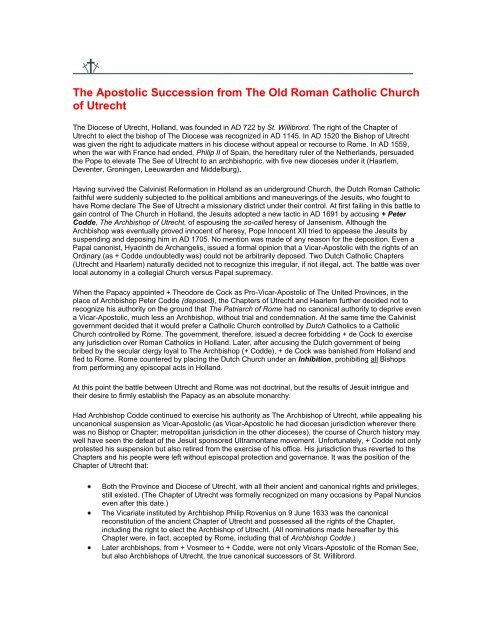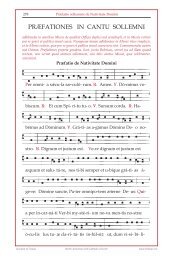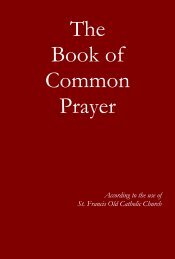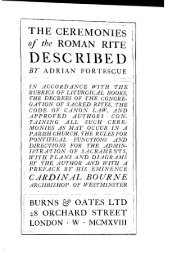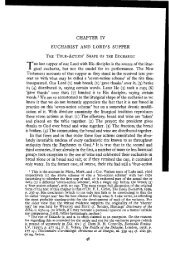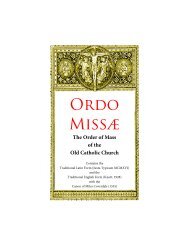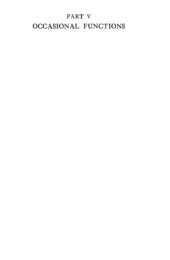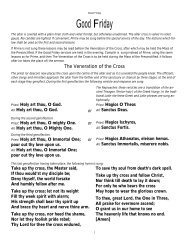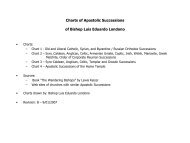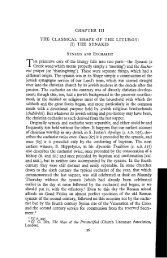Official Record of Apostolic Succession of
Official Record of Apostolic Succession of
Official Record of Apostolic Succession of
You also want an ePaper? Increase the reach of your titles
YUMPU automatically turns print PDFs into web optimized ePapers that Google loves.
The <strong>Apostolic</strong> <strong>Succession</strong> from The Old Roman Catholic Church<br />
<strong>of</strong> Utrecht<br />
The Diocese <strong>of</strong> Utrecht, Holland, was founded in AD 722 by St. Willibrord. The right <strong>of</strong> the Chapter <strong>of</strong><br />
Utrecht to elect the bishop <strong>of</strong> The Diocese was recognized in AD 1145. In AD 1520 the Bishop <strong>of</strong> Utrecht<br />
was given the right to adjudicate matters in his diocese without appeal or recourse to Rome. In AD 1559,<br />
when the war with France had ended, Philip II <strong>of</strong> Spain, the hereditary ruler <strong>of</strong> the Netherlands, persuaded<br />
the Pope to elevate The See <strong>of</strong> Utrecht to an archbishopric, with five new dioceses under it (Haarlem,<br />
Deventer, Groningen, Leeuwarden and Middelburg).<br />
Having survived the Calvinist Reformation in Holland as an underground Church, the Dutch Roman Catholic<br />
faithful were suddenly subjected to the political ambitions and maneuverings <strong>of</strong> the Jesuits, who fought to<br />
have Rome declare The See <strong>of</strong> Utrecht a missionary district under their control. At first failing in this battle to<br />
gain control <strong>of</strong> The Church in Holland, the Jesuits adopted a new tactic in AD 1691 by accusing + Peter<br />
Codde, The Archbishop <strong>of</strong> Utrecht, <strong>of</strong> espousing the so-called heresy <strong>of</strong> Jansenism. Although the<br />
Archbishop was eventually proved innocent <strong>of</strong> heresy, Pope Innocent XII tried to appease the Jesuits by<br />
suspending and deposing him in AD 1705. No mention was made <strong>of</strong> any reason for the deposition. Even a<br />
Papal canonist, Hyacinth de Archangelis, issued a formal opinion that a Vicar-<strong>Apostolic</strong> with the rights <strong>of</strong> an<br />
Ordinary (as + Codde undoubtedly was) could not be arbitrarily deposed. Two Dutch Catholic Chapters<br />
(Utrecht and Haarlem) naturally decided not to recognize this irregular, if not illegal, act. The battle was over<br />
local autonomy in a collegial Church versus Papal supremacy.<br />
When the Papacy appointed + Theodore de Cock as Pro-Vicar-<strong>Apostolic</strong> <strong>of</strong> The United Provinces, in the<br />
place <strong>of</strong> Archbishop Peter Codde (deposed), the Chapters <strong>of</strong> Utrecht and Haarlem further decided not to<br />
recognize his authority on the ground that The Patriarch <strong>of</strong> Rome had no canonical authority to deprive even<br />
a Vicar-<strong>Apostolic</strong>, much less an Archbishop, without trial and condemnation. At the same time the Calvinist<br />
government decided that it would prefer a Catholic Church controlled by Dutch Catholics to a Catholic<br />
Church controlled by Rome. The government, therefore, issued a decree forbidding + de Cock to exercise<br />
any jurisdiction over Roman Catholics in Holland. Later, after accusing the Dutch government <strong>of</strong> being<br />
bribed by the secular clergy loyal to The Archbishop (+ Codde), + de Cock was banished from Holland and<br />
fled to Rome. Rome countered by placing the Dutch Church under an Inhibition, prohibiting all Bishops<br />
from performing any episcopal acts in Holland.<br />
At this point the battle between Utrecht and Rome was not doctrinal, but the results <strong>of</strong> Jesuit intrigue and<br />
their desire to firmly establish the Papacy as an absolute monarchy.<br />
Had Archbishop Codde continued to exercise his authority as The Archbishop <strong>of</strong> Utrecht, while appealing his<br />
uncanonical suspension as Vicar-<strong>Apostolic</strong> (as Vicar-<strong>Apostolic</strong> he had diocesan jurisdiction wherever there<br />
was no Bishop or Chapter; metropolitan jurisdiction in the other dioceses), the course <strong>of</strong> Church history may<br />
well have seen the defeat <strong>of</strong> the Jesuit sponsored Ultramontane movement. Unfortunately, + Codde not only<br />
protested his suspension but also retired from the exercise <strong>of</strong> his <strong>of</strong>fice. His jurisdiction thus reverted to the<br />
Chapters and his people were left without episcopal protection and governance. It was the position <strong>of</strong> the<br />
Chapter <strong>of</strong> Utrecht that:<br />
Both the Province and Diocese <strong>of</strong> Utrecht, with all their ancient and canonical rights and privileges,<br />
still existed. (The Chapter <strong>of</strong> Utrecht was formally recognized on many occasions by Papal Nuncios<br />
even after this date.)<br />
The Vicariate instituted by Archbishop Philip Rovenius on 9 June 1633 was the canonical<br />
reconstitution <strong>of</strong> the ancient Chapter <strong>of</strong> Utrecht and possessed all the rights <strong>of</strong> the Chapter,<br />
including the right to elect the Archbishop <strong>of</strong> Utrecht. (All nominations made hereafter by this<br />
Chapter were, in fact, accepted by Rome, including that <strong>of</strong> Archbishop Codde.)<br />
Later archbishops, from + Vosmeer to + Codde, were not only Vicars-<strong>Apostolic</strong> <strong>of</strong> the Roman See,<br />
but also Archbishops <strong>of</strong> Utrecht, the true canonical successors <strong>of</strong> St. Willibrord.


